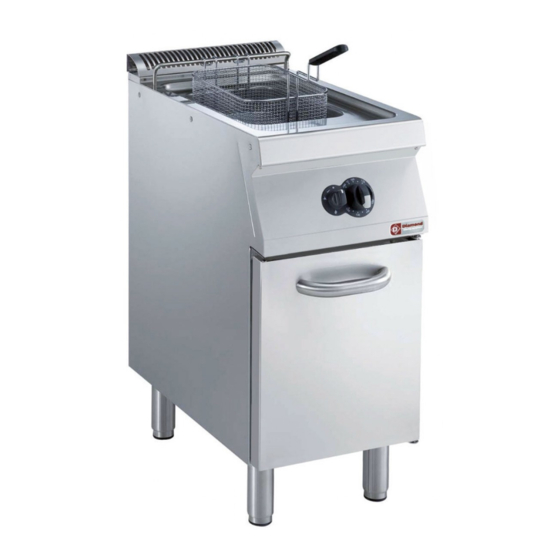Diamond +7FRED1GF0 Manual - Page 13
Browse online or download pdf Manual for Fryer Diamond +7FRED1GF0. Diamond +7FRED1GF0 15 pages.
Also for Diamond +7FRED1GF0: User Manual (15 pages), Quick Start Manual (15 pages)

VII. CLEANING
IMPORTANT!
Before carrying out any cleaning operation, disconnect the
appliance from the power supply.
1. EXTERNAL PARTS
SATIN-FINISH STEEL SURFACES (daily)
• In order to reduce the emission of pollutants into the
environment, clean the appliance (externally and when
necessary internally) with products that are more than 90
% biodegradable.
• For cleaning the stainless steel, never use detergent
products containing abrasive substances, chips, scouring
pads, brushes or scrapers in common steel.
• Clean all steel surfaces: dirt can be easily removed as
soon as it forms.
• Remove grime, fat and other cooking residuals from steel
surfaces when cool using soapy water, with or without
detergent, and a cloth or sponge. Dry the surfaces
thoroughly after cleaning.
• In case of encrusted grime, fat or food residuals, go over
with a cloth or sponge, wiping with the grain of the satin
finish and rinsing often; rubbing in a circular motion
combined with the particles of dirt on the cloth/sponge
could ruin the steel's satin finish.
• Metal objects can ruin or damage the steel: ruined surfaces
become dirty more easily and are more subject to
corrosion.
• Restore the satin finish if necessary.
SURFACES BLACKENED BY HEAT (when necessary)
Exposure to high temperatures can cause the formation of
dark marks. These do not constitute damage and can be
removed by following the instructions given in the previous
paragraph.
Important:
• Do not clean the appliance with jets of water.
• Do not use products containing chlorine (chlorine bleach,
hydrochloric acid, etc.), even if diluted, to clean the steel.
• Do not use corrosive substances (e.g. muriatic acid) to
clean the floor under the equipment.
• At the end of the product's working life, make sure it is not
dispersed in the environment.
• Our appliances are manufactured using more than 90%
metal materials (stainless steel, iron, aluminium,
galvanised sheet, etc.) which can therefore be recycled
by means of the conventional recovery structures, in con-
formity with the current regulations in the country of use.
• Make the appliance unusable by removing the power cable
and any compartment or cavity closing mechanisms (when
present) in order to avoid the risk of someone becoming
closed inside.
Advice
It is advisable to have the appliance periodically fully checked
(at least once a year). For this purpose, stipulate a
maintenance contract.
2. OTHER SURFACES
HEATED TANKS/CONTAINERS (daily)
Clean the appliance tanks or containers using boiled water,
adding soda (degreasing) if necessary. Use the accessories
(optional or supplied) specified in the list to eliminate
encrustations or food deposits.
TANKS AND COLLECTION DRAWERS (even several times
a day)
Remove any grease, oil, food residuals, etc., from trays,
drawers and containers in general used for collection. Always
clean these containers at the end of the day. While using the
appliance, empty them when they are nearly full.
IMPORTANT! With electric appliances, make sure no water
comes into contact with electrical components; water
penetration can cause short circuiting and dissipation,
tripping the appliance's protection devices.
3. FILTERS
Use of filters for oil increases the life of the oil, and in case
of reuse guarantees better cooking of food.
For cleaning, remove the filter from its seat. If the filter is
dirty with grease, wash it with degreasing soap, then rinse
and dry; at the end of the operation, refit the filter in its seat.
Replace the filter if deteriorated.
4. IDLE PERIODS
If the equipment is not going to be used for some time, take
the following precautions:
• Close cocks or main switches ahead of the appliance.
• Go over all stainless-steel surfaces vigorously with a cloth
moistened with paraffin oil in order to spread a protective
film.
• Periodically air the room.
• Have the appliance checked before using it again.
• To prevent too rapid evaporation of accumulated moisture
with consequent breakage of elements, switch electric
appliances on at minimum heat for at least 45 minutes
before reuse.
29
